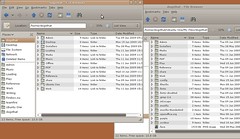Head in the Data Cloud Pt.II

A while back, I looked at the lie of the land for setting up a way of working seamlessly between two laptops running Ubuntu linux.
Originally I was going to use grsync to backup all my common application data and work files, on my personal web host. I came across a good rsync backup tutorial, plus details on syncing with Dreamhost on their personal backup server.
However, and there is always an however, I couldn't get grsync to work :( Maybe I could if I had spent another couple of hours figuring it out. But I didn't want to.
Luckily for me and my lazy ways Canonical, the commerical operation that sponsors Ubuntu, now has a service named Ubuntu One that “helps you store, sync and share”.
The service is still in beta, and I've been using it for about a week now, primarily to sync my files. There isn't an option to specifically do this, and because the freebie service is limited to 2 gigabtyes, I have had to rearrange my home folder.
Firstly, all my big files (disk images, photo archives and the like) I've put into a folder named "Offline". This, kind of obviously, doesn't get backed up.
Secondly I moved all the program settings and work data that I want to sync into the /home/username/Ubuntu One/My Files/username/ folder.
Finally I "Made Links" and put these symbolic links into my home folder /home/username/
From the sounds of it, Canonical will probably be making this process a lot easier for Joe Public. In the meantime, I'm alright Jake. I can now sync my Acer Aspire One with my ThinkPad all the night long.
Sign up for the beta program and give it a go yourself.
In next week's thrilling instalment of Head in the Data Cloud Pt.III, I'll go through how to set up Thunderbird to use GoogleMail IMAP. Oooh...

